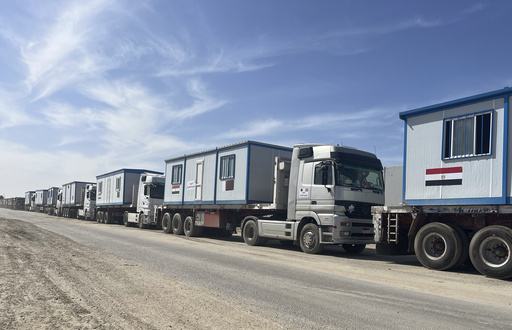CAIRO — A senior figure within Hamas announced that the militant group plans to release six living Israeli hostages on Saturday and return the remains of four deceased individuals on Thursday. This development comes as a surprise acceleration of hostages’ releases, linked to Israel’s decision to permit mobile homes and construction supplies into the severely affected Gaza Strip.
These six hostages represent the final living captives to be released during the initial stage of a ceasefire, which involves an exchange for hundreds of Palestinians currently held in Israeli facilities. Hamas leader Khalil al-Hayya shared this information in a recorded statement made available on Tuesday, indicating that the deceased individuals include members of the “Bibas family,” which has become emblematic of the sadness surrounding the hostages for many Israelis. The Israeli government has yet to verify the deaths, and officials have urged the public to refrain from circulating “photos, names and rumors” following the announcement by Hamas.
In a statement released on Tuesday by a group representing the families of the hostages, surviving relatives of the Bibas family expressed their distress, saying, “In the past few hours, we have been in turmoil. Until we receive definitive confirmation, our journey is not over.” This family, particularly Shiri Bibas and her two sons, Kfir and Ariel, have been a focal point of concern for Israel, with Hamas previously claiming their deaths occurred during an Israeli airstrike early in the ongoing conflict. Yarden Bibas, husband and father, was separately kidnapped but was released earlier this month.
The six individuals anticipated to be freed are Eliya Cohen, Tal Shoham, Omer Shem Tov, Omer Wenkert, Hisham Al-Sayed, and Avera Mengistu, as reported by the Hostages and Missing Families Forum on Tuesday. Cohen (27), Shem Tov (22), and Wenkert (23) were captured at a music festival, while Shoham was abducted from the heavily impacted Kibbutz Beeri. Al-Sayed (36) and Mengistu (39) have both been in captivity since crossing into Gaza before the October 7 attack.
The expedited release of these six hostages marks a modification of the ceasefire agreement, which initially outlined a slower process for releasing hostages and returning remains. Originally, the deal stipulated the return of bodies by the end of the first phase. The expectation is that Israel will continue to release numerous Palestinian prisoners, many of whom face life sentences for violent crimes, in exchange for the hostages, alongside releasing all women and children who were taken from Gaza since the war began.
Negotiations for a second, more complex phase of the agreement are still needed, during which Hamas is expected to release additional hostages in exchange for a long-lasting ceasefire and a departure of Israeli forces from Gaza.
In connection with the progress on hostages, an Israeli source, who sought anonymity, indicated that Prime Minister Benjamin Netanyahu had agreed to allow the entry of essential mobile homes and construction machinery needed for recovery efforts in Gaza. Hamas had previously warned that delays might occur in the release process due to Israel’s failure to permit these necessary supplies.
Efforts to bring in rubble-clearing machines began on Tuesday, with reports from an observer in southern Gaza and Egyptian state media confirming sightings of bulldozers at the Rafah border crossing aimed at clearing devastated areas. An Egyptian operator mentioned that a fleet of bulldozers and tractors awaited clearance to enter Israel.
According to a recent report from the World Bank, the United Nations, and the European Union, the rebuilding of Gaza could potentially cost around $53.2 billion, with nearly $30 billion incurred due to destruction caused by the conflict, much of which pertains to housing losses.
The ongoing ceasefire, which initiated in mid-January, has halted fighting that has resulted in over 48,000 fatalities since it began, predominantly among women and children, according to Gaza’s Health Ministry, which does not disclose the count of combatants among the deceased. Despite the temporary cessation of hostilities, the Israeli government remains intent on dismantling Hamas’ military and governance structures in Gaza. A recent proposal from U.S. President Donald Trump, which suggested relocating Gaza’s 2 million residents for redevelopment, has met substantial rejection from the Arab world and residents of Gaza, causing additional anxiety regarding the future.
Residents like Muhammad Shaaban from Jabaliya in northern Gaza reaffirmed their commitment to staying in their homeland, emphasizing, “We will not leave our country, no matter what happens.” Others echoed similar sentiments, criticizing proposals for displacement as completely unacceptable.
The first phase of negotiations outlines a gradual release of 33 Israeli hostages, with eight presumed deceased. Thus far, 19 living hostages have been released, alongside five Thai laborers taken captive. Should the forthcoming releases proceed as planned, only four bodies will remain to be returned the following week. Even with these measures, Hamas is believed to still hold around 60 captives, with many presumed dead.
The current ceasefire phase is set to last until early March, prompting apprehension about a possible return to violence as discussions on the subsequent phase were scheduled to commence at the beginning of this month.
